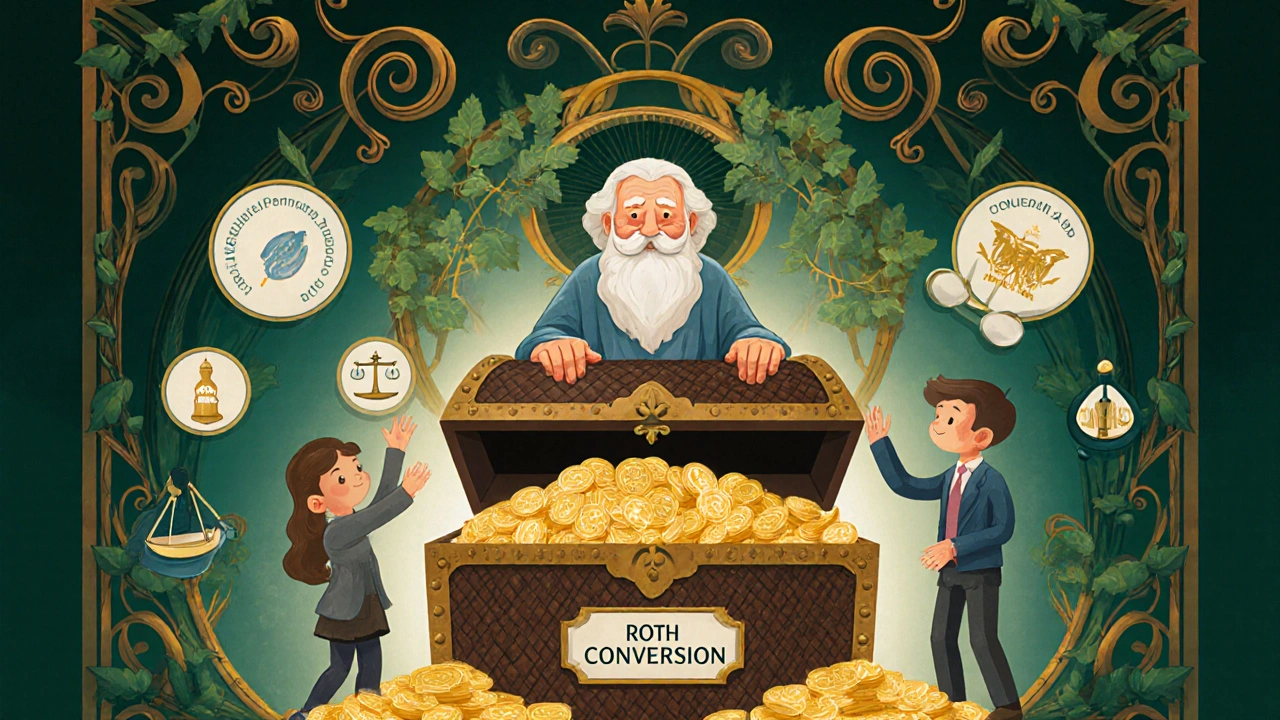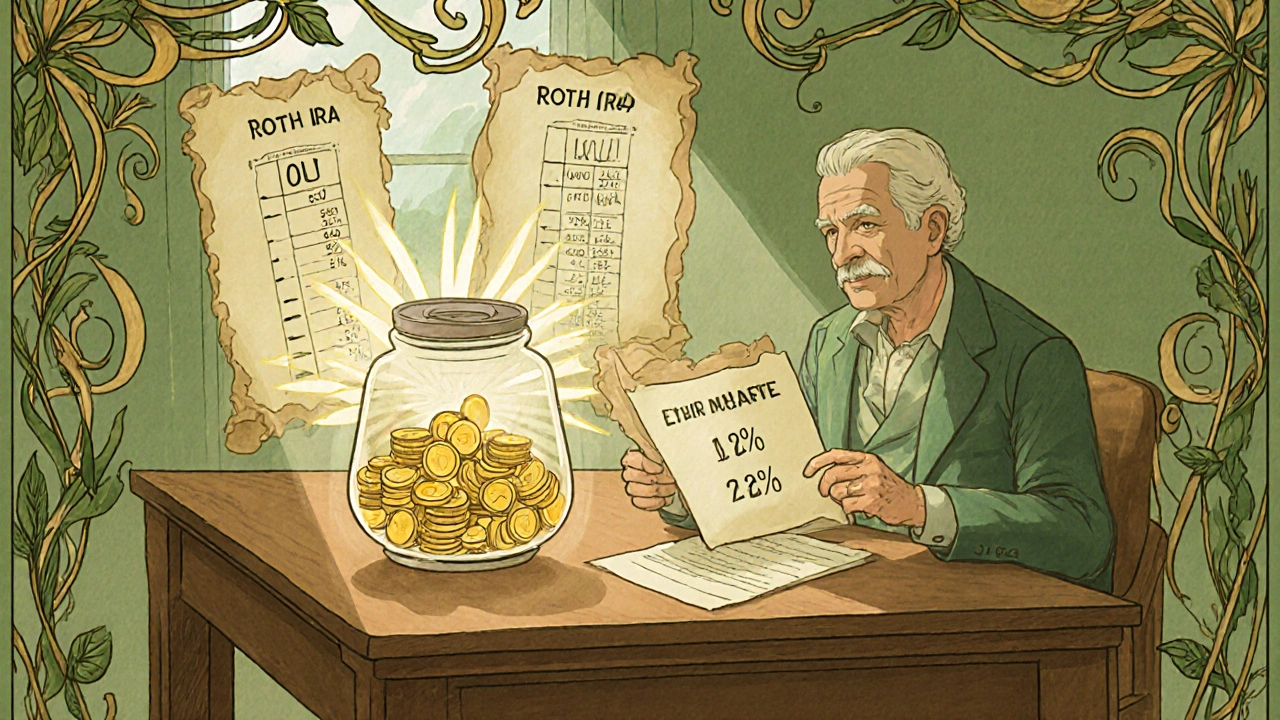Roth Conversion Tax Calculator
Calculate Your Roth Conversion Limit
Find out how much you can convert to a Roth IRA without entering a higher tax bracket for 2025.
Most people think taxes in retirement are just a fact of life. You save in a 401(k), pay nothing now, and then the IRS takes a big cut when you start withdrawing. But what if you could pay less - even far less - by acting now, in a year when your income is low? That’s the power of tax bracket management through Roth conversions.
What Exactly Is a Roth Conversion?
A Roth conversion means moving money from a traditional IRA or 401(k) into a Roth IRA. Sounds simple, right? But here’s the twist: you pay income tax on the amount you convert - right then. In exchange, every dollar you move grows tax-free and can be pulled out later without ever paying another cent in taxes. That’s the trade-off: pay now, save forever. This isn’t for everyone. If you’re still working full-time and making $200,000 a year, converting $50,000 could push you into the 32% bracket. That’s expensive. But if you’re between jobs, retired early, or taking a pay cut, those same years are golden. That’s when you fill the lower brackets.How the Tax Brackets Work in 2025
The U.S. has seven federal income tax brackets, and they’re permanent now - no more temporary TCJA expiration after 2025. Here’s what they look like for 2025:- Single filers: 10% up to $11,925, 12% up to $48,475, 22% up to $103,350, 24% up to $197,300, 32% up to $250,525, 35% up to $626,350, 37% above that.
- Married filing jointly: 10% up to $23,850, 12% up to $96,950, 22% up to $206,700, 24% up to $394,600, 32% up to $491,200, 35% up to $751,600, 37% above that.
Why Fill the Lower Brackets?
Let’s say you’re a 60-year-old retiree. Your Social Security and pension give you $60,000 in taxable income. You have $800,000 in a traditional IRA. You’re not yet taking RMDs, so your income is low. You’re in the 22% bracket. The top of the 22% bracket for a single filer is $103,350. That means you have $43,350 of room before you hit 24%. You can convert $43,350 from your IRA to a Roth IRA this year. You pay 22% on that - about $9,537 in taxes. Now, that $43,350 is in a Roth. It grows tax-free. Ten years from now, when you’re 70 and RMDs are forcing you to take out $40,000 a year, that converted amount is still growing. You don’t pay tax on it. You don’t get pushed into a higher bracket by your RMDs. You avoid Medicare surcharges. You leave more to your kids. That’s not magic. That’s math.Who Benefits Most?
This strategy isn’t for the rich. It’s for the upper-middle class - people who saved well but aren’t in the top 1%. It’s for:- Retirees between ages 55 and 70 who aren’t yet taking RMDs.
- People who took a pay cut, switched careers, or retired early.
- Couples where one spouse has passed away - the surviving spouse often drops into a much lower bracket.
- Professionals with variable income - doctors, consultants, real estate investors - who had a low-income year.

How Much Can You Convert?
Start with your current taxable income. Don’t include your IRA balance. Just your wages, pensions, Social Security, interest, dividends - anything that shows up on your 1040. Then subtract that from the top of the bracket you’re in. For example:- Married couple, $250,000 taxable income. Top of 24% bracket: $394,600. Space left: $144,600.
- Single filer, $80,000 taxable income. Top of 22% bracket: $103,350. Space left: $23,350.
The Hidden Traps
This strategy sounds easy. But people mess it up all the time. Medicare premiums (IRMAA): If your modified adjusted gross income (MAGI) goes above $103,000 (single) or $206,000 (married), your Part B and D premiums jump. A $50,000 conversion could cost you an extra $1,000 a year in premiums for five years. You need to plan for that. State taxes: In California, you pay up to 12.3% on top of federal. If you convert $100,000, you might pay $30,000 in federal taxes and $12,300 in state. That’s $42,300 gone. You need liquid cash to pay those taxes - not money from the conversion itself. If you use the converted funds to pay the tax, you’re eating 25-30% of your benefit. Alternative Minimum Tax (AMT): Conversions can trigger AMT, especially if you have big deductions like state taxes or mortgage interest. It’s rare, but it happens. Backdoor Roth confusion: Don’t mix up Roth conversions with backdoor Roth contributions. Backdoor Roth is for people who earn too much to contribute directly to a Roth IRA. It’s a different tool. Conversions are about moving existing pre-tax money.What About Other Strategies?
You might hear about tax loss harvesting, bunching deductions, or charitable giving. Those help too - but they’re one-time fixes. Tax loss harvesting lets you offset $3,000 of ordinary income per year. That’s $360 in savings if you’re in the 12% bracket. A $50,000 Roth conversion saves you $12,000 in future taxes - and that’s just the start. Bunching deductions - like donating five years’ worth of charitable gifts in one year - gives you a big deduction in Year 1, then nothing for four years. It helps you itemize, but it doesn’t change your long-term tax rate. Roth conversions are the only strategy that permanently lowers your future tax burden. They don’t just reduce taxes. They eliminate them.
When Should You Start?
The sweet spot is between 55 and 70. That’s when most people have stopped working, haven’t started RMDs, and aren’t yet collecting Social Security. Your income is low. Your tax rate is low. The future tax rate? Probably higher. Fidelity reports a 42% year-over-year increase in Roth conversions in Q1 2025. Why now? Because baby boomers are hitting that income gap. And with the 2025 tax brackets now permanent, there’s no rush to act before a deadline. But there’s still a reason to act now - because the longer you wait, the more your IRA grows. And the bigger it grows, the more you’ll be forced to pay taxes on it later.What’s Next?
Start by pulling your last tax return. Find your taxable income. Look at the 2025 brackets. Calculate how much room you have. Then ask yourself: Will I be in a higher bracket in 10 years? Will my RMDs push me into 32%? Will my kids inherit a traditional IRA and have to pay taxes on it all within 10 years? If the answer is yes - and it usually is - then you’re sitting on a tax savings opportunity. You don’t need to convert everything. You don’t need to be rich. You just need to be smart about when you pay.Final Thought
Taxes aren’t something you avoid. They’re something you manage. The people who pay the least aren’t the ones with the biggest deductions. They’re the ones who paid when the rate was lowest - and locked it in. A Roth conversion isn’t a gamble. It’s a hedge. Against higher taxes. Against inflation. Against the IRS taking more from your heirs. It’s the quiet, powerful move that changes the entire game.Can I do a Roth conversion if I’m still working?
Yes, but it’s usually not smart. If your income is already high - say, over $150,000 as a single filer - converting could push you into the 24% or 32% bracket. You’ll pay more tax now than you’d likely pay in retirement. Wait for a year when your income drops - like after you retire or during a career break.
Do I have to pay the taxes from my savings, or can I use the converted money?
Always pay the taxes from outside money - like a savings account, brokerage, or cash. If you use part of the converted amount to pay taxes, you’re reducing your Roth balance by 25-30%. That defeats the whole purpose. For example, converting $50,000 and using $12,000 to pay taxes leaves only $38,000 in the Roth. You’ve lost 24% of your benefit.
Will a Roth conversion affect my Social Security benefits?
Yes. Roth conversions increase your adjusted gross income (AGI), which can make more of your Social Security benefits taxable. If you’re already receiving Social Security, a large conversion could push your benefits from 50% taxable to 85% taxable. Plan conversions before you claim Social Security, or keep them small.
What happens if I convert too much and go into a higher bracket?
You’ll pay the higher rate only on the amount that crosses the threshold. For example, if you’re single and convert $110,000 when your income is $90,000, you’ll pay 22% on the first $13,350 above $103,350, and 24% on the rest. It’s not all at the higher rate - just the portion that spills over. But it still costs more than planned. Always calculate your conversion amount carefully.
Do I need to file any forms after a Roth conversion?
Yes. You’ll get Form 1099-R from your IRA custodian showing the conversion amount. You must report it on Form 8606 when you file your taxes. This form tracks your basis (after-tax contributions) to make sure you’re not taxed twice. Keep good records - this is one area where mistakes are common and costly.
Can I do a Roth conversion every year?
Yes. There’s no limit on how many times you can convert in a year, or how many years you can do it. Many people convert small amounts every year during low-income years. This is called “bracket smoothing” - keeping your taxable income steady in the 22% or 24% range instead of jumping around. It’s often smarter than one big conversion.
Are Roth conversions a good idea for estate planning?
Extremely. Under the SECURE Act 2.0, most beneficiaries must empty inherited traditional IRAs within 10 years. That means your kids could face a huge tax bill. A Roth IRA? No taxes. No RMDs. No 10-year rush. Converting now can turn an inherited tax bomb into a tax-free gift. First Citizens reports conversions are now 23% more valuable for estate planning since 2024.

Dave McPherson
Let’s be real - this is the kind of financial wizardry that only works if you’re already financially literate and have a six-figure IRA sitting idle. Most people don’t even know what an RMD is, let alone how to ‘fill brackets.’ The fact that you’re casually suggesting $43k conversions like it’s topping off your coffee mug? Cute. Meanwhile, my cousin just got hit with a $12k Medicare surcharge because she tried this after reading some ‘smart’ blog. Tax arbitrage isn’t a game. It’s a minefield wrapped in a 1099-R.
And don’t get me started on ‘bracket smoothing.’ That’s just fancy talk for ‘I’m too lazy to do a real tax plan.’ If you’re converting every year, you’re basically paying the IRS interest on your own money. The real secret? Don’t have an IRA in the first place. Cash flow > tax gymnastics.
Also, ‘quiet, powerful move’? Nah. It’s loud, expensive, and only benefits people who already won the game. The rest of us are just trying to afford insulin and not get evicted. But hey, at least your Roth is tax-free. Congrats.
And yes, I know I’m being dramatic. But this post reads like a hedge fund brochure written by someone who’s never had to choose between rent and groceries. Just saying.